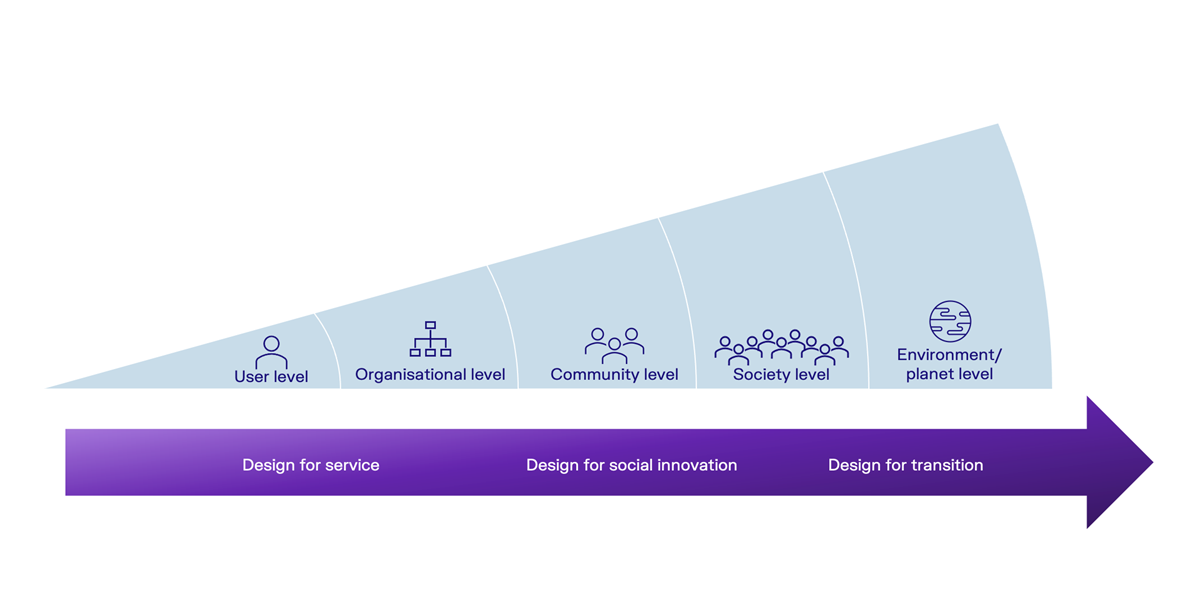Designing for Change: How service design can help us build a sustainable future
3 minute read
In the service design team we've been thinking about how we might adapt our work in the face of the challenges posed by climate change, at a scale that we can begin to implement today. We've been looking at the methods we use, the clients we work with or would like to work with, what academics have to say about the role of design in a more sustainable future and different lenses through which to view our work.
Everything is changing around us. Yearly we see global temperature records broken. Biodiversity is in decline, especially in the UK. What were once “freak” weather phenomena are increasingly common. Out-dated economic models put growth and profit ahead of health, happiness, and the nature we are part of.
As a society, those who are already excluded or minorities are likely to be hit first and hardest by changes such as land use, or water availability. The UN has acknowledged the intersectional nature of these challenges in its seventeen Sustainable Development Goals
In the service design team, we have been thinking about how we need to adapt our work in the face of these challenges, but at a scale we can tackle. Because of the versatility of service design practice, we feel we have an opportunity to fit in and provide value in new and different ways. The weirdness of Covid lockdowns gave me lots of time to think about things I care about and the work I used to do related to biodiversity and species mapping.
For several years, the design community has witnessed an expansion in discussion from user- or human-centred design to more planet- or life-centred practice. Think of, for example, Cennydd Bowles' 2019 session at Camp Digital, about how we can build better worlds; agency Snook's principles for designing sustainable services; or the work of pioneers like Jeroen Spoelstra and Marce Xirinachs and their Life-Centred Design school; or Ned Gartside’s work on developing a set of principles for the design and delivery of greener services.
Design, at least in the traditional sense, certainly doesn't offer a panacea – no heroes here! – but in collaboration with people with other expertise, we firmly believe that design has a role to play. Many of us have skills and experience to offer, coupled with a strong desire to play a part in helping us all transition to a more sustainable, even regenerative, future.
In the service design team at Nexer, we've been working over the last year to adjust and adapt our mindset and approaches. We've been looking at the methods we use, the clients we work with or would like to work with, what academics have to say about the role of design in a more sustainable future and different lenses through which to view our work.
Designing along a continuum, from services to transition
Prof Terry Irwin's 2015 "Continuum of Design Approaches" is an effective way to look at things. This describes the continuum from the mature discipline of “design for service" (where perhaps the majority of our work takes place), to the developing discipline of "design for social innovation" (where design becomes increasingly inclusive and participative), through to design for transition (or "transition design"), which is a more emergent discipline, or at least was nine years ago, and maybe leans to bigger or more radical perspectives. Irwin suggests that the scale of time, how deeply we're involved, and the range of things we consider - like social and environmental issues - all grow as we move along this continuum, as does the inherent complexity.

Figure 1: The design continuum
We have found the continuum concept useful in reflecting on past work and envisioning what we might get involved in, in the future.
Designing in this way might take different forms
Let's imagine we are in a position to work with a large (maybe national or international) conservation organisation. We're keen to work with this client because their mission to conserve and indeed improve the natural environment is balanced with a consideration of social inclusion, e.g. helping people to enjoy nature and feel connected with it, and benefit from that, as well as being balanced with the needs of other land users, for example farmers.
In this scenario, some of the “design for services" end of the work might be focused on developing a service to allow people to query or supply biodiversity data for a given region using online tools and with the involvement of expert [data] curators.
Then in terms of social innovation, we might be helping to model community engagement and activation, increasing the degree to which co-design is employed and accepted.
But then what might designing for transition look like? This is where our roles as service designers begin to dissolve into some wider, more shared work, where the emphasis is on capacity building, enablement, helping to prototype new structures, and advocating for systemic change. We recognise, too, the overlap with our future thinking & speculative design work – this is one of the key skill areas we identify for service design at Nexer – in terms of the need for "visioning for transition", imagining and exploring possible futures.
One of the interesting things that we recognise about this is that as we move further along that continuum, the work is increasingly about being facilitators and catalysts, and then being partners and amplifiers. In all cases, though, we consider the three core features of sustainability: society, economy, and environment.
Creating positive change, today
To use one of our MD Hilary's favourite phrases, we are digging where we stand. We are looking at existing work and client relationships from different angles, as well as enjoying conversations with potential new partners, like conservation organisations, housing associations, and national parks.
Ultimately, we are finding ways to quietly but deliberately expand our service design thinking and practice so that it can embrace the transition to more a sustainable and equitable future; finding ways to centre the planet, including “us” with it.
We’re exploring where our skillset might compliment the work others are doing, so if you want to chat and find common ground, we’d love to have that conversation.

Get in touch
Please email francis.rowland@nexergroup.com if you would like to know more about our service design projects, or call our Cambridge office on +44 (0)1625 427718

